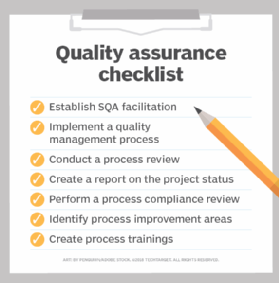
alotofpeople - stock.adobe.com
The complete guide to QA team roles and responsibilities
QA teams play an important role in ensuring quality and performance. To be as effective as possible, organizations need to be thorough in structuring and managing their QA teams.
Quality assurance (QA) is any systematic process used to ensure a product or service meets a defined standard of quality. It helps in establishing and maintaining set requirements for developing reliable products, aiming to increase customer confidence and a company's credibility.
The concept of QA as a formal practice started in the manufacturing industry and has since spread to most other industries, including software engineering.
Having a dedicated QA team helps prevent costly errors, ensures product quality and improves customer satisfaction. To get the most out of a QA team, however, it needs to be effectively organized and managed. A well-structured QA team will offer and provide consistent quality and the potential for continuous improvement.
QA team roles and responsibilities
Some responsibilities that QA roles and team members might share include:
- Execution of different software testing types, such as regression, exploratory, user acceptance and non-functional testing.
- Defect tracking and reporting.
- Collaboration with different teams.
- Planning sprints.
QA teams are made up of numerous roles, which commonly include:
How to organize a QA team effectively
Effectively organizing a QA team involves several different steps. Organizations should take note of:
- Requirements. An organization must first define its requirements for the QA team, which might include allocated budget and areas of coverage needed.
- Team prerequisites. Determining the experience, skills and overall attributes that QA team members must possess.
- Define the QA structure. QA teams can be structured in several ways, such as:
- Centralized. The classic model for QA has separate and specialized teams carry out different QA functions.
- Agile. QA testers are integrated into development teams to work closely with developers to fit Agile workflows.
- Dedicated. The dedicated QA team structure focuses on specific projects with specialized roles and phases.
- Hybrid. Combines centralized and dedicated QA models to provide early feedback and specialized testing. It aims to maintain speed while improving the predictability of releases.
- Establish clear roles. The responsibilities of each included QA role -- such as QA Engineer, Lead, Manager, Test Analyst -- should be clearly defined.
- Standardize tools. Decide on the tools that will be used for conducting tests, automating processes, integration and reporting.
- Integrate QA early on. Involving QA early in the software development life cycle (SDLC) will enable the team to find and avoid potentially costly errors early on.
- Training. Train QA teams on the tests they will perform and the tools they will use. Offer them feedback and promote continuous learning practices.
Why is QA important for maintenance and testing?
Quality assurance plays an essential part in the software development lifecycle, as it helps to ensure the long-term quality and performance of a software product.

QA teams help in making sure that a product offering meets or exceeds customer and end-user expectations. This ultimately helps build trust with the product's audience and can positively impact an organization’s credibility. As an example, an audience will respond much more positively to a completed and properly functioning product, compared to one that is unfinished or requires an update to function as intended.
Placing quality assurance processes early in the development lifecycle can help catch potentially costly bugs or issues early. Likewise, QA will help ensure that changes such as updates and future additions won’t break existing functionalities. Continuous QA testing also helps to ensure software meets a set standard for continued performance and security.
What are the top skills for a QA tester?
Skills commonly required to become a QA tester include:
- Programming. QA testers must have an understanding of or familiarity with programming or scripting languages like Python, Java or JavaScript, which are used in creating tests and debugging.
- Testing techniques. Understanding of or experience in testing techniques such as functional, unit, regression, integration and user acceptance testing.
- Testing tools. Knowledge or experience with automation testing tools such as Selenium, Cypress or JUnit.
- Defect tracking and reporting. Ability to document and communicate bugs effectively.
- SDLC knowledge. Understanding of the SDLC will aid testers in planning and executing tests at different stages of the software’s lifecycle.
- Test case management. Understanding of or experience in designing, organizing and documenting test cases.
- The basics of cloud computing. Many organizations will use cloud-based services, which means that QA testers working on these services must understand cloud architectures and how applications behave in cloud environments.
- CI/CD practices. Continuous integration and continuous deployment (CI/CD) pipelines enable QA teams to integrate automated tests into ongoing builds and deployments.
QA teams must have a collection of these technical skills to be proficient. Once you have these, read about some common interview questions asked in QA roles.







